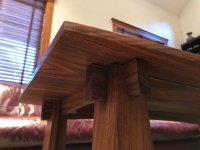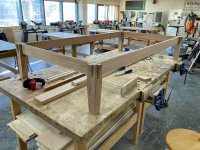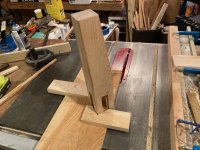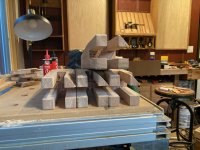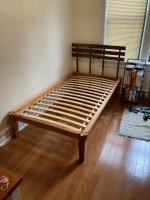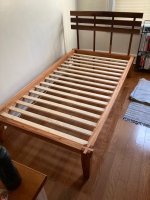smorgasbord
Member
The company has been around for at least a few years, but I just came across a couple of videos showing assembly close-ups, etc.
https://vimeo.com/408078456
and
https://vimeo.com/252260413
I used a similar joinery technique (sometimes called a "castle joint") for a coffee table I built a decade ago (that doesn't disassemble, but it's 4/4 stock and had the complication of rails curved on the bottoms):
[attachimg=1]
Anyway, I was thinking of using my Domino XL with their KD connector system, but this kind of castle joint is fun to cut and the potential for assembly/disassembly without tools is a plus.
Here's a video on making the castle joint that's similar to what I did on the coffee table.
Not practical for a bed since you'll likely bang your shins are the protruding rails.
But, interesting to me is that watching the Thuma videos, it looks like the ends bed rails are laminated, perhaps for strength. This YouTube video has the fellow doing the same thing (about 8:30 in):
I guess the idea is that there are deep notches cut in the ends of the rails, and so the very ends are at danger of with the grain splitting off. Anyone got any thoughts on that? I think the danger only exists during assembly/disassembly, so it makes sense that Thuma would do that since owners would be assembling the bed. But even so, with those pretty thick rails and dense hardwoods, I'm not sure that's really an issue. Would like to hear opinions.
https://vimeo.com/408078456
and
https://vimeo.com/252260413
I used a similar joinery technique (sometimes called a "castle joint") for a coffee table I built a decade ago (that doesn't disassemble, but it's 4/4 stock and had the complication of rails curved on the bottoms):
[attachimg=1]
Anyway, I was thinking of using my Domino XL with their KD connector system, but this kind of castle joint is fun to cut and the potential for assembly/disassembly without tools is a plus.
Here's a video on making the castle joint that's similar to what I did on the coffee table.
Not practical for a bed since you'll likely bang your shins are the protruding rails.
But, interesting to me is that watching the Thuma videos, it looks like the ends bed rails are laminated, perhaps for strength. This YouTube video has the fellow doing the same thing (about 8:30 in):
I guess the idea is that there are deep notches cut in the ends of the rails, and so the very ends are at danger of with the grain splitting off. Anyone got any thoughts on that? I think the danger only exists during assembly/disassembly, so it makes sense that Thuma would do that since owners would be assembling the bed. But even so, with those pretty thick rails and dense hardwoods, I'm not sure that's really an issue. Would like to hear opinions.

